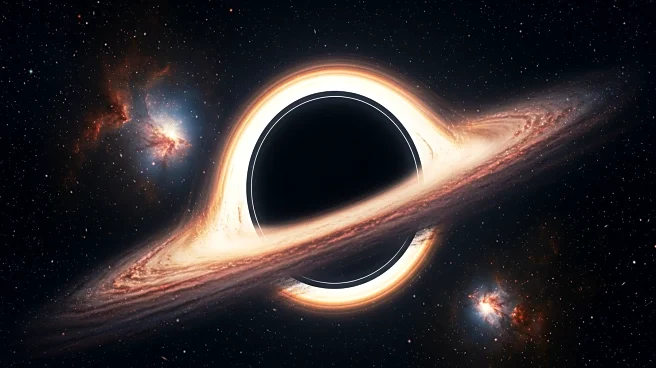What's Happening?
Astronomers have identified what may be the most massive black hole ever detected, located in the Cosmic Horseshoe galaxy. This ultramassive black hole is estimated to be 36 billion solar masses, making it 10,000 times heavier than the black hole at the center of the Milky Way. The discovery was made using gravitational lensing and stellar kinematics, which allowed researchers to measure the black hole's mass with greater certainty than previous methods. The Cosmic Horseshoe galaxy, a fossil group, is a massive structure that distorts spacetime, creating a horseshoe-shaped Einstein ring. This discovery provides insights into the relationship between supermassive black holes and their host galaxies, suggesting that galaxy growth can funnel matter into central black holes, potentially leading to quasar formation.
Why It's Important?
The discovery of this ultramassive black hole is significant for understanding the evolution of galaxies and the role of black holes in shaping them. It challenges existing theories about the upper limits of black hole mass and provides a new method for detecting dormant black holes across the universe. This could lead to a better understanding of how black holes influence galaxy formation and star creation. The findings may also impact future research on dark matter distribution and the dynamics of galaxy mergers, such as the anticipated merger between the Milky Way and Andromeda galaxies.
What's Next?
Researchers plan to use data from the European Space Agency's Euclid space telescope to detect more supermassive black holes and their host galaxies. This will help further explore the connection between black holes and galaxy formation. The study of fossil groups like the Cosmic Horseshoe may also provide insights into the end states of galaxy and black hole formation, offering a glimpse into the future of our own galaxy.
Beyond the Headlines
The discovery highlights the potential for new methods in astrophysics to uncover hidden aspects of the universe. The use of gravitational lensing and stellar kinematics could revolutionize the way astronomers measure black hole masses, especially in distant galaxies. This approach may also contribute to the study of dark matter, as understanding the distribution of mass in galaxies can provide clues about this elusive substance.











